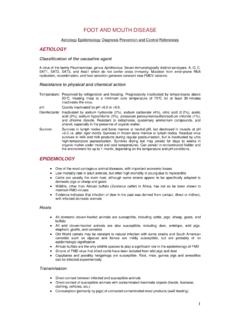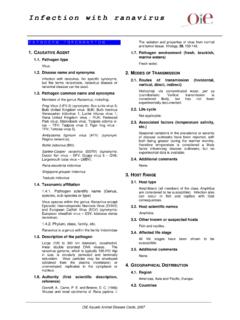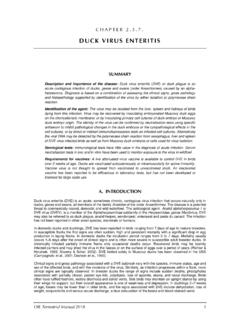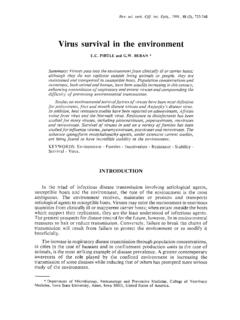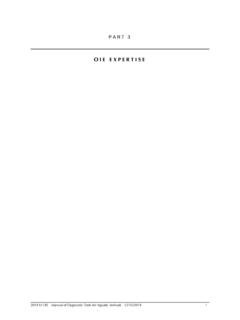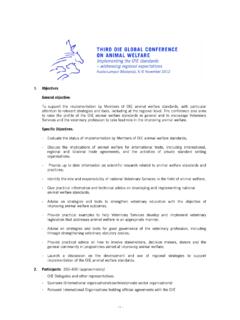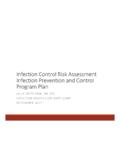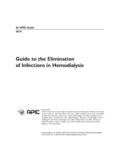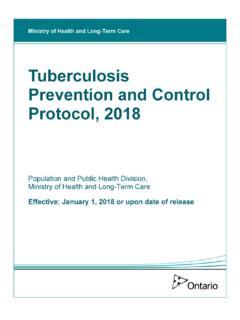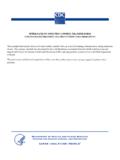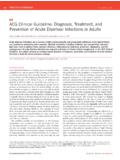Transcription of Classification of the causative agent Resistance to ...
1 RIFT valley fever . Aetiology epidemiology Diagnosis prevention and Control References AETIOLOGY. Classification of the causative agent Rift valley fever (RVF) virus is a negative-sense, single-stranded RNA virus of the family Bunyaviridae within the genus Phlebovirus. Only one serotype is recognised but strains exist of variable virulence. Resistance to physical and chemical action Temperature: Virus recoverable from serum after several months at 4 C or 120 minutes at 56 C. pH: Resistant in alkaline environments but inactivated at pH < Chemicals/Disinfectants: Inactivated by lipid solvents ( ether, chloroform, sodium deoxycholate), low concentrations of formalin and by strong solutions of sodium or calcium hypochlorite (residual chlorine should exceed 5000 ppm).
2 Survival: Survives in freeze dried form and aerosols at 23 C and 50 85% humidity. Virus maintained in the eggs of certain arthropod vectors during inter-epidemic periods. Can survive contact with phenol at 4 C for 6 months epidemiology . RVF is a vector-borne disease of sheep, cattle and goats; susceptibility of different breeds to RVF varies considerably. The disease usually presents in an epizootic form over large areas of a country following heavy rains and sustained flooding, and is characterised by high rates of abortion and neonatal mortality, primarily in sheep, goats and cattle. Hosts Cattle, sheep, goats, dromedaries, several rodents Wild ruminants, buffaloes, antelopes, wildebeest, etc.
3 Humans are very susceptible (major zoonosis). African monkeys and domestic carnivores present a transitory viraemia Transmission RVF virus regularly circulates in endemic areas between wild ruminants and haematophagous mosquitoes; disease is usually inapparent Certain Aedes species act as reservoirs for RVF virus during inter-epidemic periods and increased precipitation in dry areas leads to an explosive hatching of mosquito eggs; many of which harbour RVF virus Precipitation cycles of 5 25 years produce RVF-inmuno-na ve animal populations and when combined with introduction of virus, explosive outbreaks of the disease occur o satellite imaging has been used to confirm historic importance of precipitation in RVF.
4 Outbreaks and in forecasting high-risk areas for future outbreaks Infected Aedes feed preferentially on domestic ruminants which act as an amplifier of RVF. o broad vector range of mosquitoes (Aedes, Anopheles, Culex, Eretmapodites, Mansonia, etc.) coupled with increased circulating virus leads to expansion of disease o extrinsic incubation also occurs in vectors. Sylvatic cycle and inter-epidemic maintenance also occurs in some areas Direct contamination: occurs in humans when handling infected animals and meat Mechanical transmission by various vectors has been demonstrated in laboratory studies 1. Sources of virus For animals: wild fauna and vectors For humans: nasal discharge, blood, vaginal secretions after abortion in animals, mosquitoes, and infected meat; also by aerosols and possibly consumption of raw milk Occurrence RVF is endemic in tropical regions of eastern and southern Africa.
5 Epizootic outbreaks in Africa among peri-endemic countries have been associated with above average rain fall and climatic conditions favourable for competent vectors. Important outbreaks of RVF have been recorded in Egypt (1977 78 and 1993), Mauritania (1987), Madagascar (1990 91), Kenya and Somalia (1997). RVF was recognised for the first time outside of the African continent in 2000 with outbreaks reported in Saudi Arabia and Yemen. The disease has not established itself in the Arabian Peninsula but sero-positive animals have been detected. RVF activity was recorded from 2002 to 2004 at various locations in Senegal, Mauritania and Gambia. Madagascar and Swaziland have most recently reported RVF in 2008 and later that year also South Africa.
6 For more recent, detailed information on the occurrence of this disease worldwide, see the OIE. World Animal Health Information Database (WAHID) interface [ ] or refer to the latest issues of the World Animal Health and the OIE Bulletin. DIAGNOSIS. Incubation period varies from 1 to 6 days; 12 36 hours in lambs. For the purposes of the Terrestrial Code, the infective period for RVF is considered 30 days. Clinical diagnosis Severity of clinical disease varies by species: lambs, kids, puppies, kittens, mice and hamsters are considered extremely susceptible with mortalities of 70 100%; sheep and calves are categorised as highly susceptible with mortality rates between 20 70%; in the moderately susceptible category are cattle, goats, African buffalo, domestic buffalo, Asian monkeys and humans with mortalities less than 10%.
7 And camels, equids, pigs, dogs, cats, African monkeys, baboons, rabbits, and guinea pigs are considered resistant with infection being inapparent. Birds, reptiles and amphibians are not susceptible to RVF. Signs of the disease tend to be non-specific; however, the presentation of numerous abortions and mortalities among young animals, together with influenza-like disease in humans, is indicative. Cattle Calves (highly susceptible). o fever (40 41 C). o inappetence o weakness and depression o bloody or fetid diarrhoea o more icterus than in lambs Adults (moderately susceptible): o often inapparent infection but some acute disease o fever lasting 24 96 hours o dry and/or dull coat o lachrymation, nasal discharge and excessive salivation o anorexia o weakness o bloody/fetid diarrhoea o fall in milk yield o abortion rate may reach 85% in the herd Sheep Newborn lambs or under 2 week of age (extremely susceptible): o biphasic fever (40 42 C); fever subsides just prior to death 2.
8 O anorexia; in part due to disinclination to move o weakness, listless o abdominal pain o rapid, abdominal respiration prior to death o death within 24 36 hours Lambs over 2 weeks of age (highly susceptible) and adult sheep o peracute disease: sudden death with no appreciable signs o acute disease more often in adult sheep o fever (41 42 C) lasting 24 96 hours o anorexia o weakness, listlessness and depression o increased respiratory rate o vomiting o bloody/fetid diarrhoea o mucopurulent nasal discharge o icterus may be evident in a few animals o in pregnant ewes, Abortion storms' with a rates approaching 100%. Goat Similar to adult sheep (see above). Humans Influenza-like syndrome: fever ( 40 C), headache, muscular pain, weakness, nausea and epigastric discomfort, photophobiae Recovery occurs within 4 7 days Complications: retinopathy, blindness, meningo-encephalitis, haemorrhagic syndrome with jaundice, petechiae and death Lesions Focal or generalised hepatic necrosis (white necrotic foci of about 1 mm in diameter).
9 Congestion, enlargement, and discoloration of liver with subcapsular haemorrhages Brown-yellowish colour of liver in aborted fetuses Widespread cutaneous haemorrhages, petechial to ecchymotic haemorrhages on parietal and visceral serosal membranes Enlargement, oedema, haemorrhages and necrosis of lymph nodes Congestion and cortical haemorrhages of kidneys and gallbladder Haemorrhagic enteritis Icterus (low percentage except in calves). Differential diagnosis Bluetongue Wesselsbron disease Enterotoxemia of sheep Ephemeral fever Brucellosis Vibriosis Trichomonosis Nairobi sheep disease Heartwater Ovine enzootic abortion Toxic plants Bacterial septicaemias Rinderpest and Peste des petits ruminants Anthrax 3.
10 Laboratory diagnosis Samples Heparinised or clotted blood Plasma or serum Tissue samples of liver, spleen, kidney, lymph node, heart blood and brain from dead animals or aborted fetuses o specimens should be submitted preserved in 10% buffered formalin and in glycerol/saline and transported at 4 C. o liver or other tissue for histological examination may be placed in formol saline in the field for diagnostic purposes; facilitates handling and transport in remote areas Procedures Identification of the agent Culture primary isolation is usually performed in hamsters, infant or adult mice, or on cell cultures of various types o virus may also be detected by immunofluorescence carried out on impression smears of liver, spleen and brain Agar gel immunodiffusion useful in laboratories without tissue-culture facilities Polymerase chain reaction o used for rapid diagnosis o for antigen detection and used to detect RVF virus in mosquito pools o RT-PCR followed by sequencing of the NS(S)
